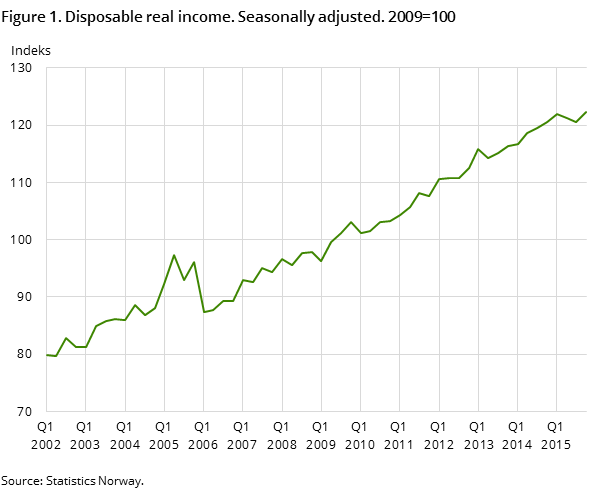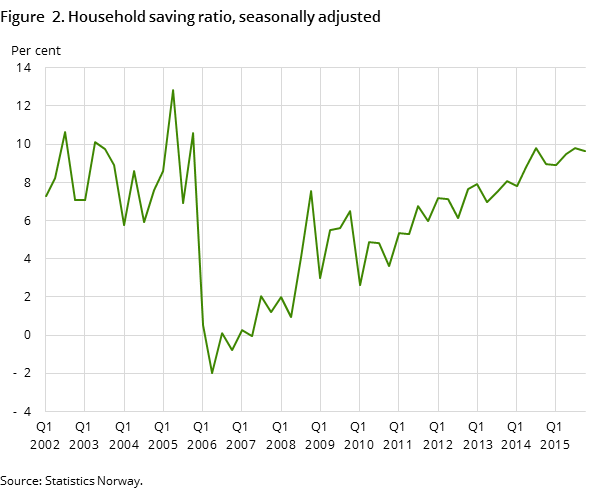Content
Published:
This is an archived release.
Household saving remains high
According to seasonally-adjusted figures, disposable income in households and non-profit institutions serving households increased by 1.8 per cent from the previous quarter. Over half of this increase came from increased benefits from general government. Saving was unchanged during the period.
| 1st quarter 2015 | 2nd quarter 2015 | 3rd quarter 2015 | 4th quarter 2015 | |
|---|---|---|---|---|
| Compensation of employees | 361 619 | 364 906 | 367 277 | 369 717 |
| Disposable income | 340 937 | 343 856 | 344 212 | 350 576 |
| Total consumption | 330 182 | 332 159 | 331 906 | 339 873 |
| Saving, net | 32 348 | 34 704 | 36 094 | 36 189 |
| Savings ratio (per cent) | 8.9 | 9.5 | 9.8 | 9.6 |
| Real disposable income, growth | 1.2 | -0.5 | -0.6 | 1.5 |


Compensation of employees was up by NOK 2.5 billion in the 4th quarter, according to seasonally-adjusted figures. Payments and benefits received from general government, mostly work-related benefits, increased by nearly NOK 3.5 billion. Property income received increased less than the reduction in property income paid, thereby making a positive contribution to growth in disposable income.
Seasonally-adjusted disposable income for households and non-profit organisations increased by NOK 6.4 billion in the 4th quarter. Overall for the year, disposable income was 4.6 per cent higher than in 2014. Real disposable income grew by 1.5 per cent in the 4th quarter and by 2.3 per cent on an annual basis.
The seasonally-adjusted savings rate for households and non-profit organisations was 9.6 per cent in the 4th quarter, while the average for 2015 is estimated at 9.4 per cent.
Disposable income of NOK 253 000 per capita in 2015
Preliminary figures show that household disposable income in 2015 was NOK 1 312 billion, which represents an increase of 4.5 per cent from the previous year. Disposable income per capita was about NOK 253 000, which is around NOK 8 500 higher than the year before. Household real disposable income increased by 1.3 per cent per capita.
Households saving increased to NOK 137 billion in 2015. Saving per capita was about NOK 26 000, compared to nearly NOK 24 000 in 2014.
Lower savings for corporations and general government in 2015
Unlike the household sector, savings in both the corporate sector and the general government decreased in 2015. In particular, savings in the general government fell significantly, which is mainly explained by the sharp decline in oil revenues. Overall, Norway’s saving in 2015 was around NOK 634 billion in 2015, which is a decrease of over NOK 120 billion from 2014.
For the corporate sector as a whole, net lending also declined from 2014 to 2015. However, in the non-financial enterprises sector the fixed capital formation was reduced by more than the reduction in income, resulting in a reduction in net borrowing. In the general government, on the other hand, fixed capital formation increased, resulting in a decrease in net lending of NOK 96 billion from 2014 to 2015.
Lower disposable income for Norway
Growth in Norway's real disposable income in 2015 was negative for the first time since 2009, which was mainly due to a deterioration in the terms of trade. The decline from 2014 was 3.1 per cent, and the price development of oil and gas contributed 4.1 percentage points to this decline. The change in terms of trade contributed overall with 5 percentage points of the decline. Production growth in the petroleum industry and on the mainland, however, pulled up real disposable income by 1.5 percentage points, while changes in income and transfers of balance of payments contributed to real disposable income increasing by 0.5 percentage points.
For more on contributions to real disposable income, see Table 6 under annual national accounts.
RevisionsOpen and readClose
Quarterly sector accounts are based on preliminary calculations. The uncertainty in the last quarter is the largest. New information is continuously being integrated into the figures, which could cause revisions in the previously released data. Quarterly sector accounts are also consolidated against the data from the quarterly national accounts data. When the last quarters of the unadjusted series are updated, seasonally-adjusted series may also be revised backwards.
Additional information
Contact
-
Pål Sletten
E-mail: pal.sletten@ssb.no
tel.: (+47) 99 29 06 84
-
Nils Amdal
E-mail: nils.amdal@ssb.no
tel.: (+47) 91 14 91 46
